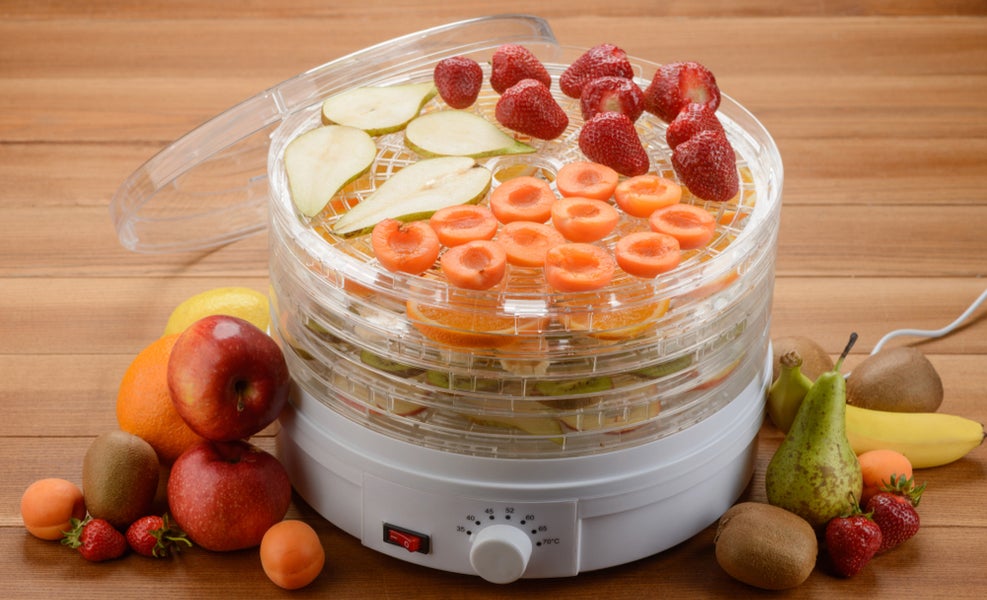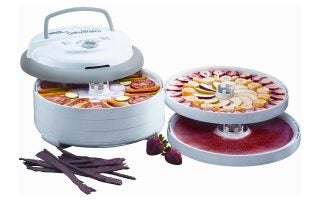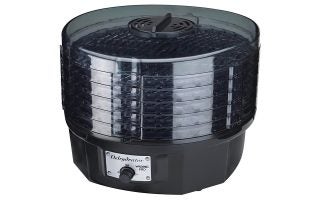Food Dehydrator Models for Beginners
Food dehydrators are small kitchen appliances used to dry or dehydrate food. Why you ask? Dehydration is a preservation technique that has been used for ages. Dehydrated foods make for great snacks, helping you eat healthier by giving you a good dose of nutrition and vitamins without any added sugars, preservatives, or other chemicals that grace store-brought snacks. They can also be used to make proper meals, coming to rescue when you go camping. Not only that, dehydrated foods are also a great way to prevent that extra produce in your refrigerator from going to waste. Still not convinced? Well, these handy kitchen gadgets also save you money and time! So get ready to expand your skills in the kitchen and get started with food dehydration.
How does it work? Food dehydrators have an in-built fan and small amount of heat which is used to dry food. They have a light flow of hot air which reduces the amount of moisture present in the food. When the moisture is removed, the shelf life of food gets increased—there is no risk of deterioration. The nutritional value of food remains the same. So you can dehydrate food easily without any worries. Think cinnamon apple crisps, peri-peri kale chips, beef jerky, and if you’re up for it…fruit roll ups.
Tips for Beginners to Use Food Dehydrators:
1. Check the temperature: For proper dehydration, proper time and temperature are required. So you have to check the temperature. The process of dehydration varies with the temperature of the dehydrator. Generally the time and temperature required for dehydration are written on the dehydrator or written in the booklet given with food dehydrator. You should also check the recipe you’re using to match, and if required adjust, the dehydration time based on the temperature.
2. 95% food is dehydrated: Before you decide that the dehydration process is complete and store your dried food, check that 95% of the food in the trays must be dehydrated. If the food is soft or spongy, then put it back into the dehydrator and give it more time. When the food item becomes crunchy and hard, it means the food is completely dry. Sometimes the indoor humidity may cause the soft texture. In which case, you should place it in the food dehydrator for some more time.
3. Don’t dry foods quickly: Dry the food properly. Ensure that depending upon the particular food (whether its fruit, veggie, or meat), you give it proper time and temperature for drying.
4. Preparation is important: Before dehydrating any food, clean your food dehydrator with an anti-bacterial cleaner. Wear the gloves and steam the low-acid vegetables for 10 minutes.
5. Increase the efficiency: The efficiency of the food dehydrator is increased by heating it before the food is added on trays. To get the best drying results, slice the food items in equal thickness, size, and shape. If the slices are uneven or different too much in size, they won’t dry at the same time, as a result you’ll have food that’s over and under dried.
How you can select the right food dehydrator?
Whenever you are deciding to buy a food dehydrator, check the fan, for it is the most important feature of the food dehydrator. Select the food dehydrator which has a fan on the back of the system, not on the top or bottom of the unit. The fan, which is mounted on the back, is best, as it allows more food to dry evenly. The fan mounted at the top or bottom of the unit allows the closest items to dry first, thereby, the process of drying isn’t always even.
For dehydration, an adjustable thermostat is best. It lets you select the correct temperature to dry different varieties of food to perfection. The capacity of the food dehydrator varies from 4 to 10+ square feet of space, and which one is right for you is based entirely on the purpose and frequency with which you want to use this machine. You should also keep in mind that the right size of the food and the right quantity affect the drying. In the same way, if you are drying large amount of food, then buy the food dehydrator which has enough space to accommodate all the food. Otherwise, smaller is better.
In terms of design, a food dehydrator is either in the stackable tray form (vertical) or slide out trays form (horizontal). Typically, start-up models are vertical whereas commercial models are horizontal.
Top 3 Food Dehydrators to Use:
1. Ronco Food 125-Watt Dehydrator
One of the least expensive models when it comes to food dehydrators, this makes for a good choice for beginners. It is quiet, small, light, and fits just about anywhere. It heats food up to 133° F, however, it does take a longer time to dry foods in comparison to some other models on the market, as it has only 5 trays. The trays are not dishwasher safe. It has a limited warranty of 10 years.
2. Nesco FD-75PR 600-Watt Food Dehydrator
You can get a powerful fan and the ability to dry quickly in a reasonable price with the Nesco FD-75. It is easy to clean, the temperature is adjustable, and it is compact. Need more to take the leap? Despite being a start-up vertical food dehydrator, the flavours of food do not mix with this machine. The cons of this dehydrator are: it has no on-and-off switch. It is loud and has no warranty as well.
3. Waring Pro DHR20 525-Watt Food Dehydrator
It is functional as well as fancy. It has an attractive exterior, top mounted fan, sealed trays, and 5 year warranty. Yes, the pros with this dehydrator are convincing. But keep in mind that it has no timer and it takes up a lot of counter space in your kitchen. So, if you’re already struggling with the space on your countertop, this isn’t the dehydrator for you. Unless, you don’t mind pulling it out of the cabinet whenever you want to use it.
Overall, you have 3 stellar options. Select any of the food dehydrators above and get started on those crisps. Best of Luck!






